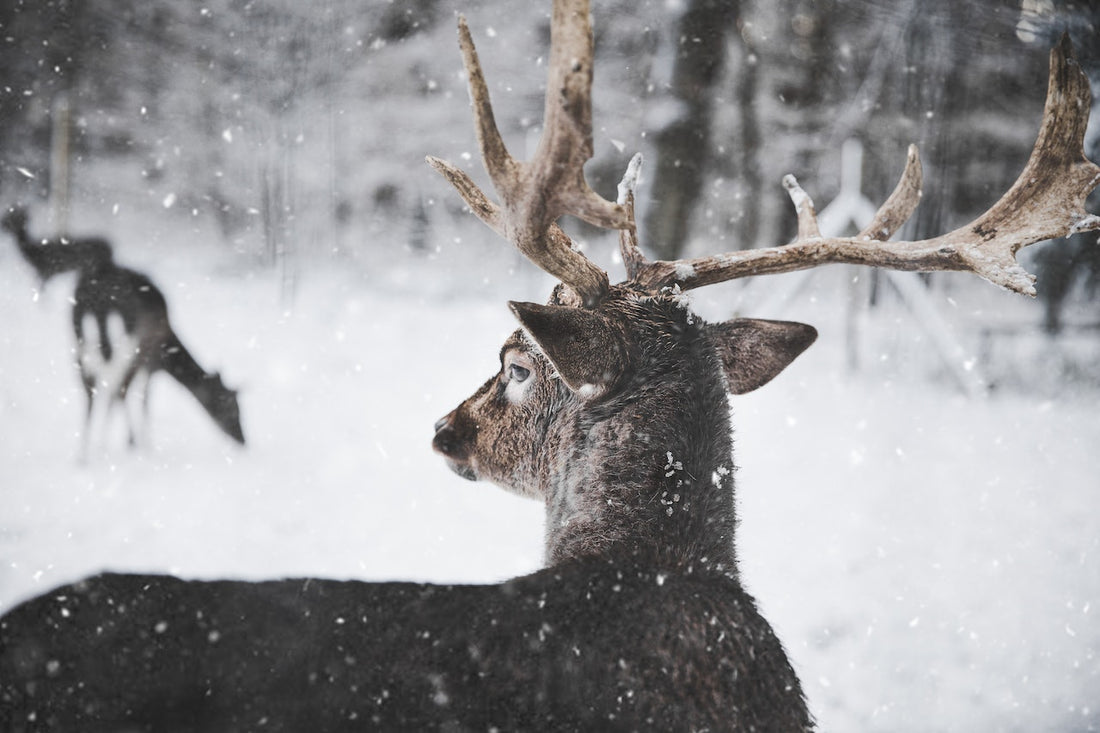In the hunting community, it is a well-known fact that the white-tailed deer is one very delectable game that you cannot afford to miss. Many hunters will try to acquire deer tags so they can hunt throughout the winter period.

This is because the cold season is when the white-tailed deer like to strut their stuff.
These deers like the cold season and, though it is not a scientific fact, they love to move around more in this frigid climate. The deer are able to do so because they grow well-insulated coats that keep them warm from the biting cold.
Though this drop in temperature presents an opportunity to quickly scamper off to your best stand—an opportunity that cannot be easily skimped on—life can throw you a mean curve.
Hunting in the cold is already tough enough.
However, when the temperature begins to drop without signs of stopping until it is below zero and the whole ground is covered in white sheets, it becomes a different ballgame entirely.
Hunting Deer In The Snow
Hunting for deer in the snow presents challenges that seem daunting. When sheets of snow cover the ground, the scarcity of deer in popular hunting areas begins to rise.
Food plots begin to get covered up.
This means that deer have to move around to find other sources of food. You could go out to your favorite stands and see little to no whitetails if the ground for miles is covered with snow, ice, and crust. This is because, as much as the bucks feel more comfortable in the cold. But they love food more because it keeps them alive.
Deers will naturally gravitate towards reliable food sources, which means that their browsing sites could change, as well as other habits you might have been banking on to make your kill.
Another reason the snow would present a huge problem would be due to the freezing temperature, which could send the human body into hypothermia.
Although it seems stressful, it’s not an impossible task. To successfully hunt whitetails in the snow, you must modify your methods. These practices are what will make the difference in the hunt.
Tips For Hunting Deer In The Snow
- Look for food plots that show promise of food:
When ice and snow create a beautiful white blanket over all the plants, they are also burying the food that whitetail deer eat. Your stand might have been efficient during other seasons, but don’t be surprised if you see very few deer—especially if the ground is covered with snow. So go ahead and set up shop somewhere else where food is most likely to be available.
- Look for high-volume food sources with shallow snow.
When the fresh snow falls, it is still easy for deer to chew on buds just below the snow because they can always dig them up. However, when the snow has piled up and ice and crust have canvassed the fields, it could present an annoying problem for the deer.
Deers tend not to favor food plots that require them to expend energy just to dig up food. So find a place where it would be easy for them to dig up the food, and you will find a lot of deer.
- Hunt in areas that have a high stem count:
Stem count simply means the number of stems shooting above the snow per acre. In some places, plants like wheat, other grain plants, and certain grasses tend to grow very tall on average. When snow falls, the plants are not entirely buried. Look for such places to make your stand because the higher stems per acre, the more deer you seem to find.
- Use hunting apparel that keeps you warm without impeding your movement.
Even though deer are not as easily spooked as they are during warmer weather, they are still very attentive and cautious. During the cold period, there will be a lot of dry twigs, plants, and branches. Approaching callously can mean giving your position away, so you need to be cautious of your movement.
Heavy clothing needed to keep you warm can definitely impede your movement, making you a bit more clumsy. Meanwhile, self-heating hunting jackets and other hunting gear offers you the same level of warmth and comfort without asking you to give up the intricate movements of the hunter.
- Avoid places that have hard crusts and ice:
If deer are going to forage around food plots that offer up their goods with little effort on the whitetail’s part, then they will definitely want to avoid the food plots that demand energy from them. Of course, such places might not be completely empty, but you will definitely find fewer deer in places like this.
Conclusion
If you have not hunted in the snow, you cannot make it without changing up your practices even a little bit. Conventional means will not work, so you must adapt. Adaptation is key.
White-tailed deer are moved mainly according to foraging opportunities.
That is, they will move to where the food or the water is. Snow falling, lakes and watering holes freezing up, and plants being buried will definitely cause the deer to wander off in search of a better browsing area. Look out for these changes in behavior to figure out how best to take advantage of them.
Make sure to plan, prepare adequately, and kit up with a heated hunting jacket and other gears. The interesting aspect of deer hunting in the snow is the opportunity it presents to bond with your family. This season makes for a good hunting trip or a lovely hunting expedition.
Regardless of what you do, the cold season is definitely not the time to shy away from the hunting grounds. It could be stressful but also super fun, scintillating, and rewarding.

